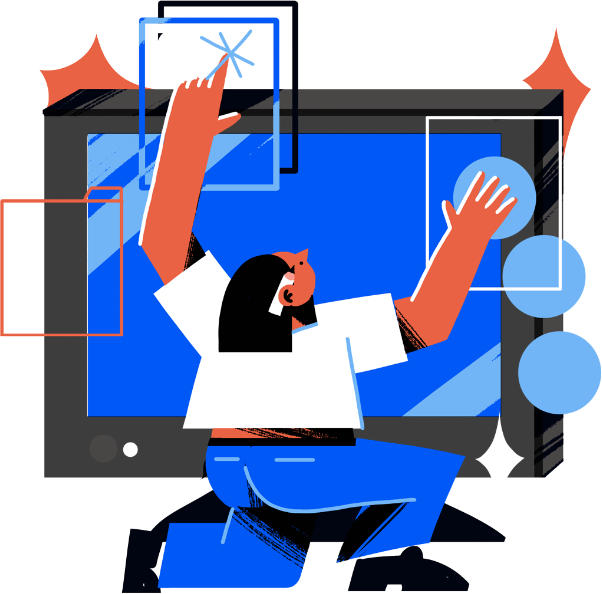Are you unfamiliar with the labyrinth of IT terms?
We’ll guide you!
With us, you won’t get lost in the language of the IT world. IT recruitment uses many of its own words. We can help you understand them and clarify exactly what kind of job or candidate you're looking for.
Do you have your own idea of your dream job or candidate?
We’ll make it come true!
What field or position are
you interested in?

A group of roles dedicated to software development and software quality management.
People in these positions tend to be technically proficient, and work directly with code or at least know how to read it (testers).
In contrast to technical skills, they do not have strong soft skills, so working with them requires a bit more patience and diplomacy than other roles.
A front-end developer is a developer who prefers to work on the user interface (front-end). He/she knows the main user interface platforms and libraries and is familiar with the available component sets. He/she is able to critique an analyst’s work or UX/UI designer’s UI design. He/she usually has a certain visual sensibility
A developer using the iOS platform for the front-end. The job description is similar to another full stack developer. Development is usually in Objective-C or Reactive Native.
A developer working on the user interface works with available component sets and uses familiar UX patterns. He/she needs the guidance of a more experienced front-end developer or full-stack developer.
A developer using C++. It is used for computing cores with high performance requirements. Not everyone likes the more difficult syntax, so knowledge of this language is appreciated.
An HTML CSS coder is a developer working with CSS. The name is usually used in web applications to manage web content. An HTML CSS coder must have perfect knowledge of HTML language and work with browser tools and support tools for sending HTML requests. An HTML CSS coder knows methods for tuning page performance and limiting page size. An HTML CSS coder is familiar with the W3C standard.
For an HTML5 developer see HTML CSS Coder.
Back-end or front-end developer using Python. Due to its simplicity, it is usually used in smaller applications with connections to obscure interfaces or in start-ups, but also in some larger solutions.
A back-end developer is a developer who prefers to work on server logic (back-end). The results of the work of a back-end developer are not seen in the user interface, but in the technical interfaces and methods used by other modules or developers. Testing the results of his/her work is more difficult than testing the front-end.
A Java programmer is a back-end or front-end developer using Java. It is typically used in large enterprise solutions with more complex business logic. He/she knows the main Java libraries and which ones are better suited to the problem at hand. He/she knows the main design patterns and knows how to apply them in practice. He/she can read technical documentation.
A full-stack developer is a developer who is willing and able to develop both the user environment (front-end) and the server logic (back-end). It is a valued skill among developers due to its flexibility.
A SW Developer is a generalist position in software development. It can mean pretty much anything, from game development in Unity to low-level hardware programming.
A developer that uses the Android platform for the front-end. The job description is similar to another full stack developer. Development is usually in Java or React Native.
A developer that uses the Android platform for the front-end. The job description is similar to another full stack developer. Development is usually in Java or React Native.
A web developer using the PHP scripting language. The name is usually used for smaller or test websites. It is rather rare in medium and larger companies.
A back-end or front-end developer using C#. Same as Java, only prefers Microsoft.
Front-end developer in Javascript. He/she has a lot of patience because JS solutions are hard to understand. He/she likes working with a browser and JS debugging tools. Fans of the Angular framework are able to argue for hours against using the React framework and vice versa; sometimes you can find similarities with fans of Sparta and Slavia football clubs.
A developer role. This name is too general and can mean anything from DevOps to QA to solution design. Want the company offering the job to know at least the language, the main responsibilities and size of the development team.
Senior IT systems development role. He/she sets out the rules for the development of large-scale information systems and the rules for the integration of their modules. He/she knows the main architectural rules, the system integration rules and also knows the limitations and types of individual interconnected systems. He/she is well versed in design patterns. His/her work is similar to that of an enterprise architect.
He/she handles collecting, storing, keying and reporting over large datasets. He/she has perfect knowledge of working with standard datasets, plus he/she is proficient with the big data platform. In this position you will encounter technologies such as Scala, Hadoop, Spark, Kafka, Hive, etc.
A role responsible for software quality control. According to the assignment documentation, he/she verifies that a delivery conforms to the specified functionality. He/she designs, maintains, executes and evaluates manual tests. Manual testing is about manual “clicking”.
A role responsible for software quality control. According to the assignment documentation, he/she verifies that a delivery conforms to the specified functionality. He/she designs, writes, maintains, runs and evaluates automated regression functional tests. He/she can distinguish between automation and manual test scenarios. He/she also uses manual testing. For automated testing, knowledge of the programming language in which the tests are written is required.
A front-end developer is a developer who prefers to work on the user interface (front-end). He/she knows the main user interface platforms and libraries and is familiar with the available component sets. He/she is able to critique an analyst’s work or UX/UI designer’s UI design. He/she usually has a certain visual sensibility
A developer using the iOS platform for the front-end. The job description is similar to another full stack developer. Development is usually in Objective-C or Reactive Native.
A developer working on the user interface works with available component sets and uses familiar UX patterns. He/she needs the guidance of a more experienced front-end developer or full-stack developer.
A developer using C++. It is used for computing cores with high performance requirements. Not everyone likes the more difficult syntax, so knowledge of this language is appreciated.
An HTML CSS coder is a developer working with CSS. The name is usually used in web applications to manage web content. An HTML CSS coder must have perfect knowledge of HTML language and work with browser tools and support tools for sending HTML requests. An HTML CSS coder knows methods for tuning page performance and limiting page size. An HTML CSS coder is familiar with the W3C standard.
For an HTML5 developer see HTML CSS Coder.
Back-end or front-end developer using Python. Due to its simplicity, it is usually used in smaller applications with connections to obscure interfaces or in start-ups, but also in some larger solutions.
A back-end developer is a developer who prefers to work on server logic (back-end). The results of the work of a back-end developer are not seen in the user interface, but in the technical interfaces and methods used by other modules or developers. Testing the results of his/her work is more difficult than testing the front-end.
A Java programmer is a back-end or front-end developer using Java. It is typically used in large enterprise solutions with more complex business logic. He/she knows the main Java libraries and which ones are better suited to the problem at hand. He/she knows the main design patterns and knows how to apply them in practice. He/she can read technical documentation.
A full-stack developer is a developer who is willing and able to develop both the user environment (front-end) and the server logic (back-end). It is a valued skill among developers due to its flexibility.
A SW Developer is a generalist position in software development. It can mean pretty much anything, from game development in Unity to low-level hardware programming.
A developer that uses the Android platform for the front-end. The job description is similar to another full stack developer. Development is usually in Java or React Native.
A developer that uses the Android platform for the front-end. The job description is similar to another full stack developer. Development is usually in Java or React Native.
A web developer using the PHP scripting language. The name is usually used for smaller or test websites. It is rather rare in medium and larger companies.
A back-end or front-end developer using C#. Same as Java, only prefers Microsoft.
Front-end developer in Javascript. He/she has a lot of patience because JS solutions are hard to understand. He/she likes working with a browser and JS debugging tools. Fans of the Angular framework are able to argue for hours against using the React framework and vice versa; sometimes you can find similarities with fans of Sparta and Slavia football clubs.
A developer role. This name is too general and can mean anything from DevOps to QA to solution design. Want the company offering the job to know at least the language, the main responsibilities and size of the development team.
Senior IT systems development role. He/she sets out the rules for the development of large-scale information systems and the rules for the integration of their modules. He/she knows the main architectural rules, the system integration rules and also knows the limitations and types of individual interconnected systems. He/she is well versed in design patterns. His/her work is similar to that of an enterprise architect.
He/she handles collecting, storing, keying and reporting over large datasets. He/she has perfect knowledge of working with standard datasets, plus he/she is proficient with the big data platform. In this position you will encounter technologies such as Scala, Hadoop, Spark, Kafka, Hive, etc.
A role responsible for software quality control. According to the assignment documentation, he/she verifies that a delivery conforms to the specified functionality. He/she designs, maintains, executes and evaluates manual tests. Manual testing is about manual “clicking”.
A role responsible for software quality control. According to the assignment documentation, he/she verifies that a delivery conforms to the specified functionality. He/she designs, writes, maintains, runs and evaluates automated regression functional tests. He/she can distinguish between automation and manual test scenarios. He/she also uses manual testing. For automated testing, knowledge of the programming language in which the tests are written is required.

Roles in this group tend to have a broader overview than development teams or operations teams. Although they do not know the details of individual solutions, they can assess their position in business processes. In general, these roles are more abstracted and closer to the business than other IT roles.
This is an overlapping role that is not just IT infrastructure or just development, but is above them. An EA addresses the business view of IT and processes in a company, moves it to the level of the TOGAF methodology and has a high-level view. The intent of enterprise architecture is to determine how an organisation can most effectively achieve its current and future goals.
The main role of an IT solution architect is to transform requirements into a design that becomes a model for effective solutions. An IT solution architect is responsible for defining the architecture of the system delivered in the context of a specific solution and, as such, may include a description of the entire system or only its specific parts.
A team member who represents the business or user community from a product perspective. He/she is also responsible for working with a user group to determine what features a product should have. He/she is responsible for defining the project vision and communicating it transparently to the development team, customers and the company. The product owner defines priorities, decides which functionality to work on first, which to work on later and which not to work on at all. This role is defined only in the Scrum methodology.
A role standing between end users and the development team. He/she must understand both the company’s business and the development process, as well as constraints of the solution design. He/she practically translates requests from users to the development team and sets user expectations. He/she possesses very good communication skills and draws up written agreements. He/she is closer to business processes than an IT analyst; knowledge of process modelling is expected.
He/she works with data and creates reports from them according to business requirements. A data analyst is expected to have knowledge of working with data, data onboarding, data evaluation, knowledge of SQL query language and knowledge of data presentation platforms (data analytics).
A role standing between end users and the development team. He/she knows the IT solution in detail and designs a detailed IT solution based on user requirements. Knowledge of databases and an understanding of application code at a reading level is expected.
He/she ensures the system runs on a daily basis. He/she monitors user logs and reports, communicates any outages, performs daily maintenance, handles system updates and end-user support. He/she requires knowledge of the system and its functionalities.
He/she manages the database layer of an application, usually in production environments. He/she also manages database servers, provides backup and maintenance of data and databases. A database administrator also performs database updates and helps deploy new versions.
He/she is responsible for the development of the database layer of an application from the design process, implementation and maintenance of the database system.
This is an overlapping role that is not just IT infrastructure or just development, but is above them. An EA addresses the business view of IT and processes in a company, moves it to the level of the TOGAF methodology and has a high-level view. The intent of enterprise architecture is to determine how an organisation can most effectively achieve its current and future goals.
The main role of an IT solution architect is to transform requirements into a design that becomes a model for effective solutions. An IT solution architect is responsible for defining the architecture of the system delivered in the context of a specific solution and, as such, may include a description of the entire system or only its specific parts.
A team member who represents the business or user community from a product perspective. He/she is also responsible for working with a user group to determine what features a product should have. He/she is responsible for defining the project vision and communicating it transparently to the development team, customers and the company. The product owner defines priorities, decides which functionality to work on first, which to work on later and which not to work on at all. This role is defined only in the Scrum methodology.
A role standing between end users and the development team. He/she must understand both the company’s business and the development process, as well as constraints of the solution design. He/she practically translates requests from users to the development team and sets user expectations. He/she possesses very good communication skills and draws up written agreements. He/she is closer to business processes than an IT analyst; knowledge of process modelling is expected.
He/she works with data and creates reports from them according to business requirements. A data analyst is expected to have knowledge of working with data, data onboarding, data evaluation, knowledge of SQL query language and knowledge of data presentation platforms (data analytics).
A role standing between end users and the development team. He/she knows the IT solution in detail and designs a detailed IT solution based on user requirements. Knowledge of databases and an understanding of application code at a reading level is expected.
He/she ensures the system runs on a daily basis. He/she monitors user logs and reports, communicates any outages, performs daily maintenance, handles system updates and end-user support. He/she requires knowledge of the system and its functionalities.
He/she manages the database layer of an application, usually in production environments. He/she also manages database servers, provides backup and maintenance of data and databases. A database administrator also performs database updates and helps deploy new versions.
He/she is responsible for the development of the database layer of an application from the design process, implementation and maintenance of the database system.

A role that handles a user’s experience of using software. They are responsible for the sensory appearance of the applications designed and the consistency of the user interface. They suggest the components used and design patterns related to the user interface. As a user, you can tell at a glance if money was saved on this.
He/she designs the user interface of an application. He/she draws screen prototypes and defines component behaviour, validates prototypes with users, performs usability tests. He/she can also design non-visual interfaces.
He/she takes care of the user’s overall impression of an application or group of applications. He/she specifies which type of interface to use. He/she creates prototypes, defines component behaviour, validates prototypes with users, performs usability tests and creates graphical manuals. He/she ensures consistency of the user interface across modules.
He/she is responsible for bringing a game to a market-ready state. He/she handles input from both the technical and creative teams. He/she usually wears multiple hats and has to understand a little bit of everything.
He/she designs the user interface of an application. He/she draws screen prototypes and defines component behaviour, validates prototypes with users, performs usability tests. He/she can also design non-visual interfaces.
He/she takes care of the user’s overall impression of an application or group of applications. He/she specifies which type of interface to use. He/she creates prototypes, defines component behaviour, validates prototypes with users, performs usability tests and creates graphical manuals. He/she ensures consistency of the user interface across modules.
He/she is responsible for bringing a game to a market-ready state. He/she handles input from both the technical and creative teams. He/she usually wears multiple hats and has to understand a little bit of everything.

These roles handle the software development process. They make sure that the development process works without obstacles and, if they occur, they take care of them. Even if it’s to deliver missing coffee. Last but not least, these roles communicate with the company’s management.
A project manager is responsible for the budget, deadlines and delivery of an IT project. He/she uses traditional planning techniques. He/she serves as a contact person in case confusion arises, for example, between departments. He/she is typically found in the corporate world with less flexible development methodologies. This role is replaced by the product owner role in companies using the agile methodology.
A scrum master manages the development process when the Scrum methodology is used. He/she is responsible for compliance with scrum rules and evangelises the scrum to the company’s management. A scrum master removes barriers to using the scrum.
An agile leader is an interim role in the transformation of a company to the agile development methodology. He/she removes barriers to the introduction of the agile development methodology. The role of agile leader requires very good knowledge and experience with agile methodologies.
He/she manages an IT solution development programme. Project managers report to him/her. The programme manager position is typically found in the corporate world with less flexible development methodologies.
A project manager is responsible for the budget, deadlines and delivery of an IT project. He/she uses traditional planning techniques. He/she serves as a contact person in case confusion arises, for example, between departments. He/she is typically found in the corporate world with less flexible development methodologies. This role is replaced by the product owner role in companies using the agile methodology.
A scrum master manages the development process when the Scrum methodology is used. He/she is responsible for compliance with scrum rules and evangelises the scrum to the company’s management. A scrum master removes barriers to using the scrum.
An agile leader is an interim role in the transformation of a company to the agile development methodology. He/she removes barriers to the introduction of the agile development methodology. The role of agile leader requires very good knowledge and experience with agile methodologies.
He/she manages an IT solution development programme. Project managers report to him/her. The programme manager position is typically found in the corporate world with less flexible development methodologies.

Roles related to the software business.
They are responsible for the return on a proposed solution and its sale to customers.
They usually play an important role in setting development priorities, but they do not know the details of the solution or the link to business processes.
He/she adapts enterprise software solutions to specific customer needs. He/she is present on-site at the customer’s location, so his/her role is usually travel related. An IT Sales Consultant customises the default version of enterprise information systems to meet a customer’s specific needs. He/she negotiates the details of necessary adjustments and implements them. The role of an IT sales consultant is found, for example, in ERP solutions (enterprise resource planning systems). This is not a business role, but identifying and implementing the exact details of changes.
He/she negotiates contracts with customers for the delivery of IT solutions. They include both box solutions (ready-made information systems) and custom development. He/she is responsible for ensuring that the development department has enough orders. His/her role is not necessarily related to managing people. The word manage in this case does not refer to people, but to sales. He/she handles customer relations.
A business role responsible for the maintenance and development of a product provided by an organisation. He/she usually focuses on product strategy, and IT development is one of the many areas that support product servicing. A broader role than product owner or programme manager.
IT team leader is a role with responsibility for a development team, typically comprising a few members. He/she ensures that team members have enough work to do and is accountable for the quality of the work they deliver. An IT team leader practically handles the coordination of development work both within the team and with other teams. Typically, he/she is not involved in development, but more in organisational matters.
This is a role on the borderline between development and operations. He/she deploys new releases to the environment and maintains both test and production environments. The devops engineer position uses scripting languages, and a superior knowledge of operating systems, typically Linux, is desirable.
This is a generic name for the field of software product development. Typically, developers or DevOps specialists work here.
This is a role in the development of multi-tenant cloud products. He/she ensures the reliability of operation of cloud products, both during the design of the application and during operation. A site reliability engineer must be very familiar with the features and limitations of the cloud platform used.
This role is responsible for the quality of a delivery. He/she knows methods for testing information systems and knows database query languages. Ideally, a QA engineer knows the languages and tools for developing automated tests. A QA engineer knows how to document tests and how to report test results.
He/she adapts enterprise software solutions to specific customer needs. He/she is present on-site at the customer’s location, so his/her role is usually travel related. An IT Sales Consultant customises the default version of enterprise information systems to meet a customer’s specific needs. He/she negotiates the details of necessary adjustments and implements them. The role of an IT sales consultant is found, for example, in ERP solutions (enterprise resource planning systems). This is not a business role, but identifying and implementing the exact details of changes.
He/she negotiates contracts with customers for the delivery of IT solutions. They include both box solutions (ready-made information systems) and custom development. He/she is responsible for ensuring that the development department has enough orders. His/her role is not necessarily related to managing people. The word manage in this case does not refer to people, but to sales. He/she handles customer relations.
A business role responsible for the maintenance and development of a product provided by an organisation. He/she usually focuses on product strategy, and IT development is one of the many areas that support product servicing. A broader role than product owner or programme manager.
IT team leader is a role with responsibility for a development team, typically comprising a few members. He/she ensures that team members have enough work to do and is accountable for the quality of the work they deliver. An IT team leader practically handles the coordination of development work both within the team and with other teams. Typically, he/she is not involved in development, but more in organisational matters.
This is a role on the borderline between development and operations. He/she deploys new releases to the environment and maintains both test and production environments. The devops engineer position uses scripting languages, and a superior knowledge of operating systems, typically Linux, is desirable.
This is a generic name for the field of software product development. Typically, developers or DevOps specialists work here.
This is a role in the development of multi-tenant cloud products. He/she ensures the reliability of operation of cloud products, both during the design of the application and during operation. A site reliability engineer must be very familiar with the features and limitations of the cloud platform used.
This role is responsible for the quality of a delivery. He/she knows methods for testing information systems and knows database query languages. Ideally, a QA engineer knows the languages and tools for developing automated tests. A QA engineer knows how to document tests and how to report test results.


